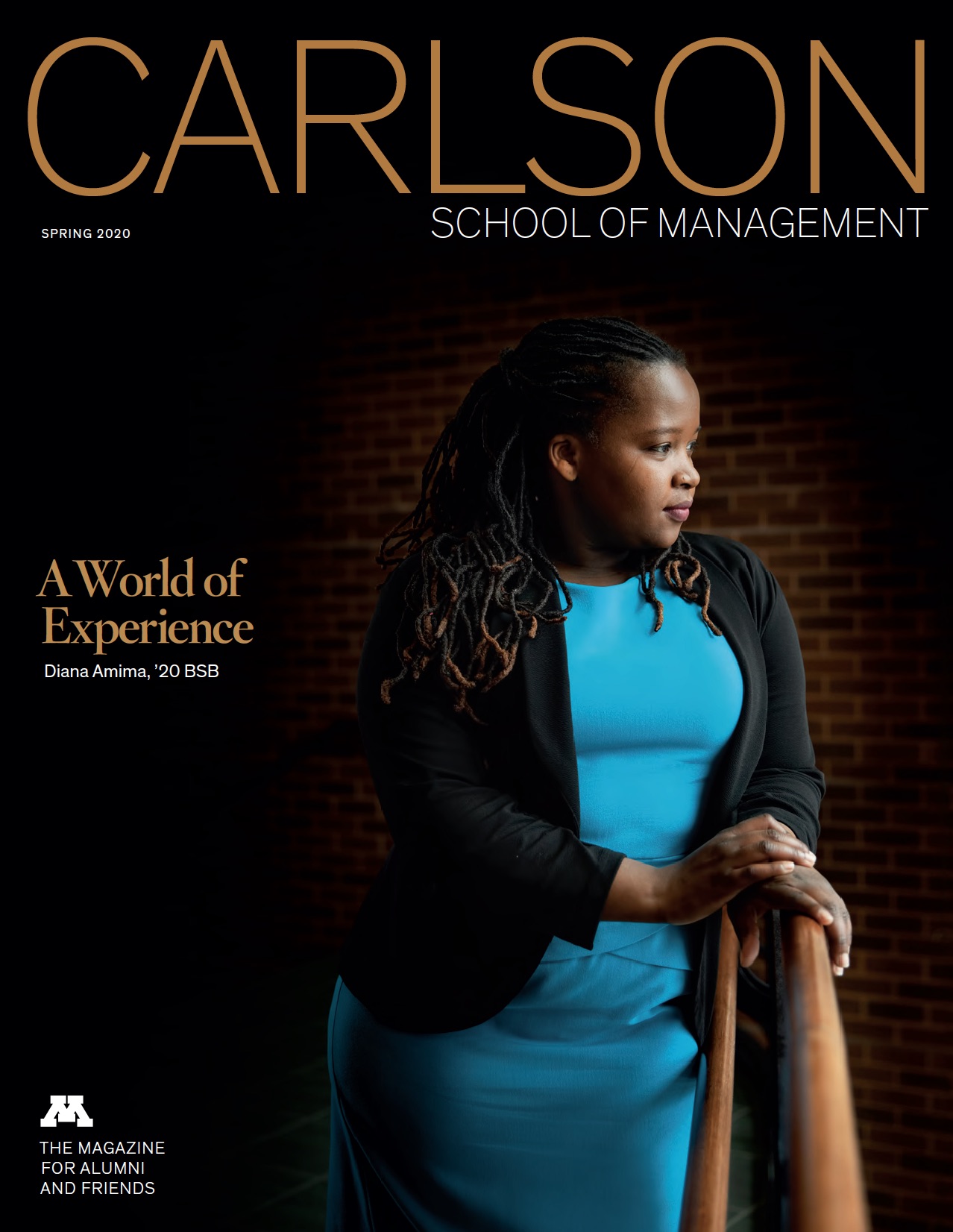
Global View
Monday, March 23, 2020
BY JOEL HOEKSTRA
Drawing on data worldwide, Carlson School faculty are investigating trends and practices that affect businesses and people across the planet—and often, their findings change the way we look at the world.
The world has shrunk significantly in the last half century. Airplanes have replaced ocean liners, delivering people and packages to distant places in record time. Free trade agreements have facilitated faster commerce between countries and across continents. A simple mouse click can send a message around the globe in an instant. It’s a small world, after all.
Simultaneously, our understanding of the planet has exploded—at least in terms of data. Phones can track when people get up and where they go. Apps can access buying habits, and company data and communications can be accessed and analyzed in previously unthinkable ways.
Within all this information, there are insights into how our small world works. And increasingly, Carlson School faculty are investigating global issues and evaluating international business practices to understand the implications this data may have on the world. Sometimes, as these faculty stories illustrate, research helps us see how places and people are different, and in other cases, the research reveals how, at root, we are not so different after all.
Shopping Habits in China
It’s no secret that the internet has changed the world’s shopping habits: Online retail is the fastest-growing sector in the U.S. and is expected to grow at a double-digit rate for the foreseeable future. Online markets in other countries are also exploding. As consumer purchasing moves online, many retailers might be tempted to stop investing in physical stores. Nowadays, only a fool sinks money into bricks and mortar, right?
Not so fast, says Jason Chan, an associate professor of Information and Decision Sciences at the Carlson School. It’s true that classic retailers like Macy’s and JCPenney have fallen on hard times and begun to close locations in recent years, Chan notes, but many big-name brands, such as Nike and Nordstrom, have begun opening “concept stores” where customers can view, touch, and “experience” their products. Even Amazon, the online-retail pioneer, has gotten into the game, with physical kiosks that sell food and books.
Chan thinks there may be merit in this multi-channel strategy. He recently collaborated with researchers in China to author a paper titled “The Role of Physical Stores in the Digital Age,” which examines sales data from a large Walmart-like retailer in China. When a colleague at Nanjing University invited Chan to join him in exploring the data set, he jumped at the chance.
“It was huge and richly detailed—we could see the product SKUs, pricing, sizes, and about everything related to the retailer’s sales,” Chan says. The researchers compared online sales in regions where stores had just opened with online results in areas where the retailer had no presence. “We wanted to see if establishing a physical building in a region impacted online sales in any way,” Chan says.
Additionally, Chan and his colleagues wondered if consumers buy certain products online, but other ones—particularly ones that involve touch and feel—in stores. “We call it conspicuous function,” Chan says. “When consumers see, experience, and touch products in person, it reduces their uncertainty about product dimensions, texture, and quality.” On the other hand, shoppers might like the convenience of online buying for “low touch” items such as laundry detergent. But when it comes to purchasing “high touch” items such as clothing, they prefer an in-store experience.
The study, which is pending publication, found online sales increased significantly after a store opening. Essentially, the physical presence added to the retailer’s overall revenues. (Several pundits fear that physical stores often led to “cannibalization,” but Chan and his colleagues found the reverse to be true.)
Interestingly, in-store display of products can boost online purchasing. “Brand names stick in our heads, and we rely on brands that stay at the top of our minds when we shop online,” Chan explains. “The stuff that is advertised in-store tends to be what jumps out to us when we see different brands on the screen.”
The results were eye-opening, but Chan shies away from drawing overly broad conclusions. Buying habits in China, where consumers often rely on the expertise of salespeople in making decisions, can differ from those in America or other countries. “It remains to be seen how multi-channel strategies play out in different countries,” Chan says. “There’s an international aspect that would be interesting to explore further.”
Monitoring Management in India
Not every investor has the stomach for foreign investment. Emerging markets, for example, often present shareholders with opportunities to reap ample returns—but there are associated risks, too. Cultural issues may affect the business in ways investors don’t fully grasp. Laws and regulations that govern financial transactions elsewhere may not apply. There may be misunderstandings with leadership—or worse. “In countries with weak shareholder protections, investors may worry that management will steal money from investors,” says Nan Li, an assistant professor of Accounting at the Carlson School.
One frequent concern is related-party transactions (RPTs), which occur when managers conduct business with firms or other individuals they already know—and who stand to benefit from the established relationship. A CEO may offer a sweetheart deal to a relative, for example, or a majority shareholder may push the company to borrow money from an old friend. “RPTs can be common and costly to minority shareholders,” Li says. “It’s a serious issue for investors in India, China, and Korea.”
India recently took steps to mitigate problems associated with RPTs. “India’s corporate sector is dominated by large business groups,” Li explains. “A single individual or family usually maintains de facto control of all group firms.” In 2013, following a major financial scandal that was exposed by suspicious RPTs, Indian legislators revised the country’s corporate laws to require publicly traded companies to seek shareholder approval for certain RPTs before they take place. Under the rule, major RPTs must be voted on by a company’s shareholders. What’s more, only “disinterested” parties are allowed to vote, excluding those who might have a stake in the transaction. To pass, a RPT resolution must gain the approval of a “majority of the minority.”
Does it work? Li evaluated a sample of more than 300 RPT votes, comparing them against non-RPT resolutions. Unlike standard votes, he found, RPT votes were more likely to encounter dissent from shareholders, suggesting that shareholders often harbored doubts about such dealings. In some cases, RPTs were voted down. “Shareholder votes can act as a credible threat,” Li says. Merely having to hold a shareholder vote may act as a deterrent—prompting management to steer clear of RPTs, particularly financial ones, rather than risk embarrassment or failure.
The results have implications for policymakers in India and elsewhere. RPTs aren’t all bad, Li notes: “RPTs can help business groups overcome market frictions.” But without monitoring, RPTs can also be used to expropriate minority shareholder’s wealth, as manager transfer assets, make purchases, and authorize transactions that may line the pockets of their friends or family.
Li says the study contributes to the literature of shareholder activism at countries around the world. “While this study focuses on India as an important emerging market, the insights may potentially be carried to other countries or settings,” Li says. “I found that mandatory RPT voting has had a positive effect on shareholder value and makes Indian firms more attractive to foreign institutional investors.”
Keeping People Healthy in Developing Countries
Public health in many developing countries depends on getting antimalarial drugs, HIV medications, vaccines, and contraceptives to people who need them ASAP. But even when funding is authorized and available to procure essential health supplies, public health clinics may encounter supply chain issues that affect health-care delivery. Insufficient inventory at a location—also known as a stock-out—may result in patients walking away empty-handed.
Karthik Natarajan, an assistant professor of Supply Chain and Operations at the Carlson School, once served as a consultant to USAID, a global development agency that works in many countries to improve the performance of public health supply chains. Natarajan contributed to a project aimed at improving supply chain efficiency in the delivery of anti-retroviral drugs, and became interested in how supply chains affected the work of aid agencies and other nonprofits.
The supply chain is the backbone of the healthcare system. Any break in the chain can lead to stockouts of health supplies.
“The supply chain is the backbone of the healthcare system,” Natarajan says. “Any break in the chain can lead to stockouts of health supplies.”
As part of a research study, Natarajan, PhD candidate Amir Karimi, Associate Professor Anant Mishra and Professor Kingshuk Sinha explored stock-outs of contraceptives in five developing countries. Examining supply chains that served clinics in Bangladesh, Haiti, Malawi, Senegal, and Tanzania, the researchers tried to identify how changes aimed at improving the supply chain impacted the likelihood of stock-outs. One proposed solution aimed at getting clinics to update their inventory systems daily; another focused on pushing clinics to track inventory electronically, rather than on paper. Natarajan and his colleagues set out to find out whether each solution in isolation, or both used in tandem made a difference. They also examined whether commodity range (the number of products offered by a clinic) made any difference in the likelihood of stockouts.
“Our results indicate that the likelihood of stock-outs increases with an expansion in the range of health commodities offered,” the authors concluded in the piece. The more goods a clinic had to track, one might conclude, the more likely it is that the inventory records may not be accurate or that reordering something will slip through the cracks. But reducing range isn’t always an acceptable solution: A patient might prefer a particular type of contraceptive, for example, or might ask for drug A instead of drug B—though both are effective.
Natarajan found the optimal commodity range for clinics was to stock between 7 and 8 types of contraceptive methods. “Increasing range beyond that had a significantly negative impact, leading to a substantial increase in stock-outs,” he says. “That has policy implications. In many areas, there’s a blanket recommendation that suggests you should have as wide a range as possible. If 10 products are available, you should offer all 10.”
Maintaining commodity range in any facility depends on clinic staff, however, who must restock supplies as they run low. Natarajan and his colleagues found that tracking supplies daily reduced the incidence of stock-outs at urban clinics, but switching from paper to electronic systems had no significant effect. At rural clinics, however, tracking products daily and investing in an electronic system was beneficial, but simply adopting one practice without the other had little impact. “That has implications for resource allocation,” Natarajan observes. “If you’re the Ministry of Health and you have to decide where to make investments, this research gives you a sense of where to put your money and effort.”
Cultural Heritage in the C-Suite
Shareholders depend on top bosses to make smart decisions. But executives are not automatons. They make decisions based on past experience, education, and other factors. To understand decision- making in the C-suite, it’s helpful to know the resumé of each player.
It may also be useful to be familiar with a CEO’s cultural heritage, says Tracy Yue Wang, a professor of Finance at the Carlson School.
“Prior research has shown that specific life and career experience influence CEO’s preferences,” Wang says. “Cultural heritage is a more fundamental and persistent source of influence, as it is instilled early in life.” Wang and colleagues from two other universities set out to determine how cultural heritage might affect a CEO’s attitude towards uncertainty and the appetite for engaging in mergers and acquisitions.
Cultural heritage often plays a role in our decision-making, even if we don’t know it, according to studies conducted by Dutch social psychologist Geert Hofstede. Using surveys conducted from around the world, Hofstede identified several core social characteristics of a society and developed indices to measure their prevalence in each nation’s population. Individualism is a strong cultural value in the heritage of Australians and Americans, for example, but not important to most people in Thailand. The index cannot predict individual values, of course, but it does aim to identify widespread traits in cultural heritage. Research suggests that cultural heritage can shape descendants for many generations, even if they have emigrated to other countries.Wang’s research suggests that the persistence of the cultural heritage effect exists not only in the layman population, but also in the C-suites.
Corporate leaders’ risk preferences are shaped by their cultural origins, and…in turn shape the risk culture of the companies that they lead.
Wang and her colleagues determined the cultural origins of more than 13,000 CEOs of U.S. publicly traded companies, using last names and various other information sources. Once the cultural background of each executive had been verified, they linked their past mergers and acquisitions (M&A) histories and sorted them into groups based on country of origin. The study confirmed that Hofstede’s belief that culture affects decision-making could be seen in CEOs’ choices regarding M&A. For instance, Wang notes, “We discovered that, on average, companies led by CEOs with a German heritage conduct significantly less
M&A relative to companies led by CEOs with a less uncertainty-averse cultural heritage such as British heritage. Conditional on M&A occurring, CEOs of different cultural heritage also have different preferences in the choice of target firms.”
Wang says the results suggest that cultural heritage is a fundamental and persistent determinant of CEOs’ preferences—and this can be useful to shareholders looking to understand a CEO’s appetite for uncertainty. “Corporate leaders’ risk preferences are shaped by their cultural origins, and corporate leaders’ risk preferences in turn shape the risk culture of the companies that they lead,” she says. “Thus, understanding corporate leaders’ cultural origins can help us understand the corporate culture as well as corporate decision making.”




